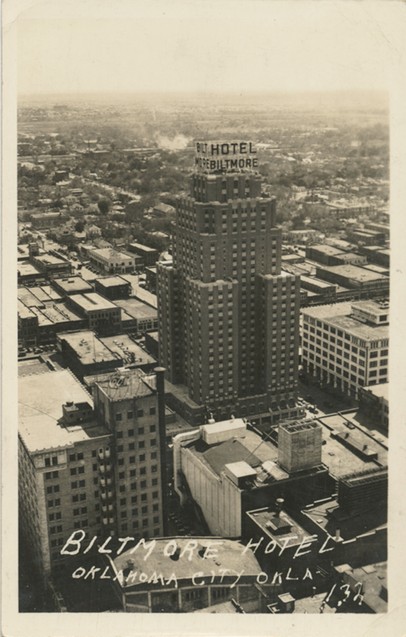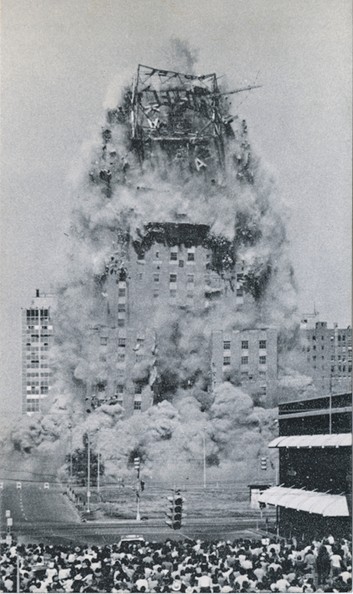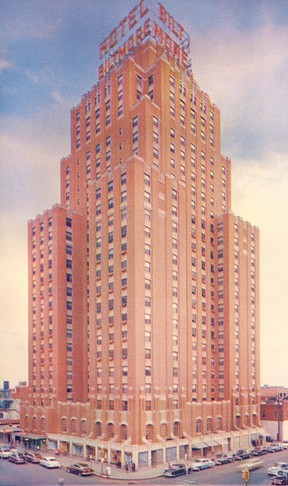Oklahoma Biltmore Hotel
Introduction
Text-to-speech Audio
The Biltmore Hotel rose during the skyscraper boom of the early 1930s. Following such luminaries as First National, Ramsey Tower and the Petroleum Building, the 600-room Biltmore was 26 stories when completed in 1932 on Grand Ave, two blocks west of the main concentration of hotels on Broadway.
The art deco Biltmore was the site of many now-legendary events in the city and a crowd of 30,000 Oklahoma Citians came Downtown to wish the old hotel a fond farewell on Sunday, Oct 19, 1977. The next to last major building to fall, the Biltmore was the largest steel structure ever demolished at the time.
Images
Biltmore Hotel, 1940

Biltmore Hotel Demolition, 1977

Biltmore Hotel, 1956

Backstory and Context
Author-Uploaded Audio
Audio commentary provided by legendary Oklahoma City newsman Gan Matthews
Text-to-speech Audio
The Biltmore Hotel rose during the skyscraper boom of the early 1930s. Following such luminaries as First National, Ramsey Tower and the Petroleum Building, the 600-room Biltmore was 26 stories when completed in 1932 on Grand Ave, two blocks west of the main concentration of hotels on Broadway.
The art deco Biltmore was the site of many now-legendary events in the city including the famous dice game on Christmas Eve, 1945 when gambler Percy Wade rolled a "hard six" and won the title to Cattlemen's Restaurant from bootlegger Hank Frey.
The hotel had always struggled financially but in 1961 the Sheraton chain bought it and pumped over $1 million into improvements to modernize it. Such an act of faith by an outside investor brought hope to urban renewal supporters just as the program was ramping up. Venerable Grand Ave., once the seat of the Overholser empire, had gone into decline so businessmen seized the opportunity to capitalize on the investment by petitioning the city to rename the street Sheraton Ave in an attempt to revive the reputation of the street. Although the city council agreed with the rationale, they decided the name smacked of favoritism and compromised by naming it after Gen. Phil Sheridan, founder of Forts Reno and Sill.
In the Pei Plan, the Sheraton-Biltmore was to remain standing and indeed the planned large garden park was to be designed around it. Ultimately, even a deep pockets chain like Sheraton could not make the hotel profitable and the company chose to move operations to a cleared city-block site on Broadway across from the new convention center. The final Myriad Gardens design did not feature the hotel.
A crowd of 30,000 Oklahoma Citians came Downtown to wish the old hotel a fond farewell on Sunday, Oct 19, 1977. The next to last major building to fall, the Biltmore was the largest steel structure ever demolished at the time.
Sources
"Biltmore is City "Within Itself" With." Daily Oklahoman (Oklahoma City) March 8th, 1932. .22.
Campbell, Gene. "Skirvin Owner Given 99-Year Biltmore Lease." Daily Oklahoman (Oklahoma City) February 24th, 1960. .1.
Wenske, Paul. "Blast Topples Biltmore Hotel." Daily Oklahoman (Oklahoma City) October 17th, 1977. .1.
Wenske, Paul. "Old Biltmore Hotel's Days are Numbered." Daily Oklahoman (Oklahoma City) August 28th, 1977. .21.
Metropolitan Library System Special Collections
Metropolitan Library System Special Collections
Metropolitan Library System Special Collections
